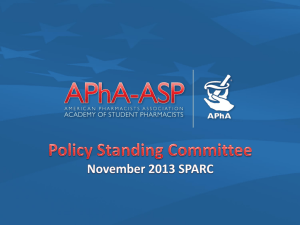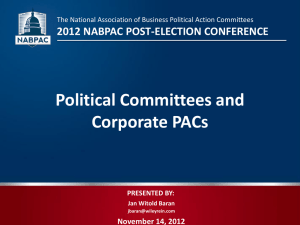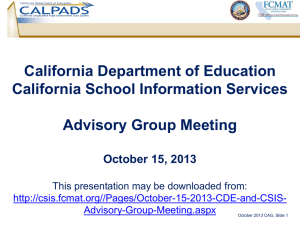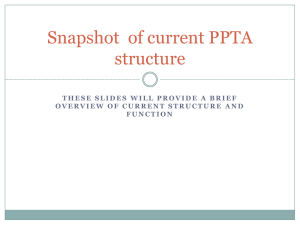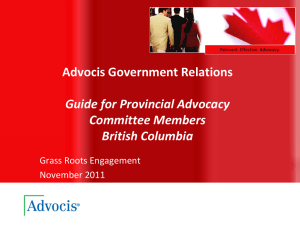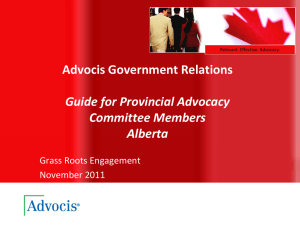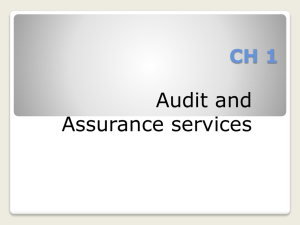Zahirul Hoque, The Relationship between Public Accounts and
advertisement
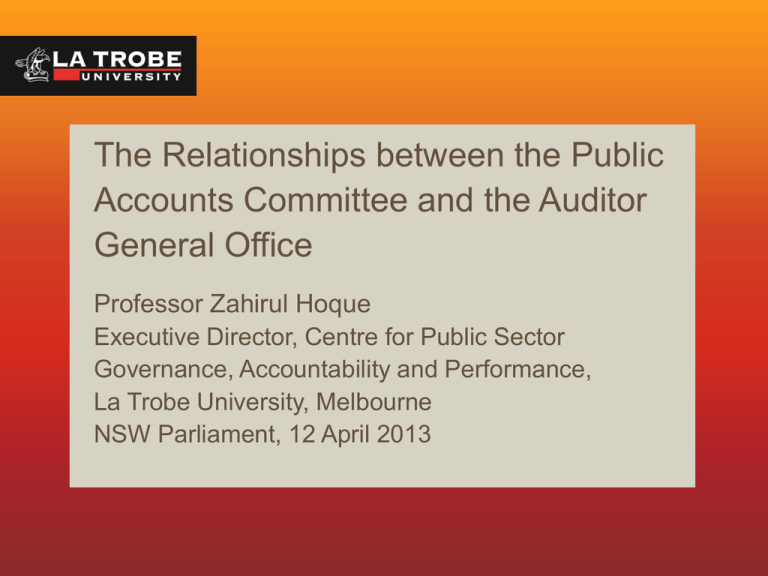
The Relationships between the Public Accounts Committee and the Auditor General Office Professor Zahirul Hoque Executive Director, Centre for Public Sector Governance, Accountability and Performance, La Trobe University, Melbourne NSW Parliament, 12 April 2013 Parliamentary oversight: components of the Westminster model of governance the preparation of the government’s annual public accounts; internal control exercised by the Executive over its financial transactions; the subsequent audit conducted by the CAG; and the related scrutiny provided by Parliamentary committees specially the PAC of the Parliament 2 Complexity in the network The AG reports to the executive (Government). The AG tables his/her reports to the Parliament on the results of a wide range of financial and performance audits. Image area After tabling the reports by the parliament, the PAC summons the executive and the AG for committee hearings. Other actors: Public interest group Media 3 The PAC’s role - good governance and accountability process in the public sector To ensure parliamentary follow-up on CAG’s reports. The parliamentarians can use the information in the CAG audit report as a basis for adjusting policies and priorities, in addition to ensuring the proper stewardship of public resources. The CAG is the producer of audit reports whereas the PAC is the principal user of those reports on behalf of the government. 4 The CAG’s role CAG audit provides not only a commentary on what has happened, but also draws attention to administrative malfunctions that have resulted in barriers to economic, efficient and transparent public administration. The CAG auditors’ responsibility in this case is to find a way of selecting and presenting information that will convey, in summary form, an accurate, objective and representative account of whether the responsibility assigned has been satisfactorily discharged. 5 The relationship between the PAC and the CAG The relationship between a PAC and CAG is a critical part of public sector accountability (McGee, 2002; Jones and Jacobs, 2006). Part of a PAC’s role is to bolster the effectiveness of the CAG (McGee, 2002). A good relationship with the CAG is a cornerstone of public sector accountability and performance. The PAC and the CAG office are separate organizations, with separate mandates and complementary roles. 6 Is the CAG auditor an agent of change? Audit symbolizes a cluster of values (i.e., independent validation, efficiency, rationality and visibility) and contemporary society is characterised by the explosion of audit, a process evident in the New Public Management (NPM) reform of the public sector and the rise of performance or ‘Value for Money’ (VFM) auditing (Power (1996) . Therefore, the CAG auditor acts as an agent of change for the public sector. 7 CAG’s dual roles On the one hand Auditors-General are the central figures in the new pluralist public accountability and that they have emerged as the champions of transparency and good governance. On the other hand the Auditors-General have also emerged as managerialism’s leading critics – or as ‘cuckoos in the managerialist nest’ (Mulgan (2001) 8 Strategic alliances between the CAG office and the PAC The longer term alliances between the CAG office and the PAC are influenced by memories of past events, interpretations of the present, and expectations of future behaviour, not just on the relationship between the PAC and the CAG office but also on the part of other parties in the action net. Alliances are therefore not only complex spatially, with diverse ties, but complex temporally. 9 The PAC and the CAG office – protect and advance public interest The relationship between the two is inevitably indispensable, one without the other being meaningless and inoperative. The existence of an effective relationship between the PAC and the CAG is a sine qua non of a good democratic system. This relationship complementary. can be viewed as 10 Case study - Bangladesh The CAG office of Bangladesh was created in 1973 in accordance with the constitution The CAG office also derives authority from the Comptroller and Auditor General’s (Additional Functions) Act, 1974 and subsequent amendments. Historically, the CAG is a political appointment of the ruling government. 11 Case study – Bangladesh cont’d The vision of the CAG office is ‘promoting accountability and transparency in public financial management for achieving good governance’. The annual budget of the CAG is not voted on by the Parliament, but is scrutinized and approved by the Ministry of Finance. The President of the Republic appoints the CAG. Only the President, based on the recommendation of a Supreme Judiciary Council, can remove the CAG. The CAG is functionally organized into 11 audit directorates, each headed by a Director General (DG). 12 Case study – Bangladesh cont’d CAG has changed the audit approach to move to wide scale performance and social audit in order to identify the roles of the government, NGOs and aid giving agencies. The CAG office also moved towards environmental audit. To combat corruption and malpractice CAG is using Forensic auditing methods to detect fraud. On average, the CAG publishes thirty statutory audit reports every year e.g. annual reports on ministries, special audit reports, Appropriation Account reports and Finance Account reports. The CAG’s reports are restricted until they have been cleared by the Parliament. 13 The PAC The PAC hearings are not open to the public, so the public remains in the dark about the committee’s activities. The PAC does not have a permanent office. The Chairman has a poorly equipped office without any permanent staff. Staff are hired from the CAG office and the Parliament Secretariat. 14 Relationships between the PAC and the CAG in Bangladesh The PAC and CAG have a strong linkage in ensuring accountability of the government. The CAG produces audit reports whereas the PAC is the principal user of those reports. The PAC depends on the CAG, often termed as “friend, philosopher, and guide” of the Committee. The working papers of the PAC are prepared by the respective Audit Directorates in conformity with the agenda of the Committee. The CAG office supports the PAC with secretarial service and technical advice, briefing PAC before PAC meetings and assisting at hearings. Officers from Audit Directorates are also present in the meeting to assist the CAG and the PAC. 15 The relationships between the PAC and the CAG – cont’d “The CAG has no formal line relationship with the PAC, but the informal working relationship is excellent”. “This is a strange relationship. It has no formal structure. It has no institutional framework to define it. But we have been trying since 1991 to develop a tradition or custom through which we hope eventually some sort of framework will develop, will evolve. But so far we have not been able to do so” (The AG) “They (CAG and PAC) effectively work together as a team in promoting accountability and effective governance”. “Linking CAG and PAC functions more effectively requires political parties to nominate PAC members who have proper expertise and experience, not based on membership seniority in the party”. “The CAG office emphasised strengthening communication between auditor and auditee organisations, and implemented workshops and seminars series with the PAC in order to resolve unsettled audit observations”. 16 Conclusion The PAC’s capacity to act efficiently and effectively is dependent on the CAG’s reports. The CAG office is also dependent on the PAC for its smooth operations. The relationships between the CAG office and the PAC are a function of their socio-political and institutional environment and strategic agendas. To have an effective coalition or strategic alliance, various agents within these two entities need to align their interests with the requirements of the institutional environment. The CAG office and the PAC are key institutions of accountability. The CAG is the lynch pin; assessment of how public funds are utilised efficiently and effectively largely depends on the CAG office, but the PAC is the final authority to address the concerns raised by the CAG office. 17 Thank you!

